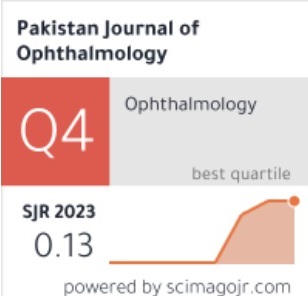Surgical Management of Orbital Fractures Using X-ray Film Plate: a Retrospective Case Series
http://doi.org/10.36351/pjo.v37i2.1111
DOI:
https://doi.org/10.36351/pjo.v37i2.1111Keywords:
Orbital fracture, X-ray film, Diplopia.Abstract
Purpose: Orbital trauma is associated with orbital blowout fractures, with associated globe injuries and loss of vision. Orbital reconstruction can be done with various implant materials. The aim of this study is to identify the safety and postoperative outcomes of using X-ray films as orbital implants during orbital reconstruction surgery.
Study Design: An interventional case series.
Place and Duration of Study: Ophthalmology departments of Lahore General Hospital and Mayo Hospital, Lahore from June 2001 to May 2017.
Methods: Retrospective data of all the patients who came for orbital reconstruction surgeries from June 2001 to May 2017 was retrieved. All patients had undergone CT scan prior to surgery. Orbital reconstruction was done by a single surgeon, by bridging bony defect with sterilized X-ray film. All patients received post-operative antibiotics for 1 week.
Results: Twenty three male patients were included in the series, with a mean age of 28 ± 2.47 years. Assault and sports injuries with a ball were the commonest form of trauma. Diplopia was the major presenting complaint in 91% of the patients. All patients underwent surgical reconstruction of the orbital floor of orbit with sterilized
X-ray film using a lateral canthotomy approach. Only mild postoperative diplopia was recorded in 7 of the cases, with uneventful recovery in the majority.
Conclusion: Sterilized X-ray film is a safe, cost effective, and durable material for reconstruction after orbital blowout fracture, especially in developing countries.
Key Words: Orbital fracture, X-ray film, Diplopia.






